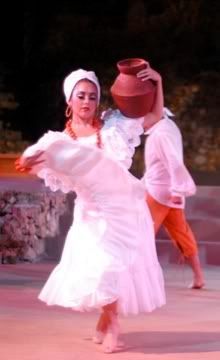Grandeza Mexicana Folk Ballet Company Presents: Tercera Raiz July 26, 2008
Hollywood, California 90068
GRANDEZA MEXICANA FOLK BALLET COMPANY
PRESENTS “TERCERA RAIZ” AT THE FORD JULY 26, 2008
Premiere explores African influences on Mexican culture
Los Angeles, CA – May 20, 2008 -- Grandeza Mexicana Folk Ballet Company (GMFBC) proudly presents its newest concert production, Tercera Raiz, to be held at the historic Ford Amphitheatre at 8:00 p.m. on July 26th. The evening features a historic perspective of the modern influence of African cultures in present day Mexican folk.
Tercera Raiz or Third Root, is the term used to reflect the third component (African descendents) of the historical ethnic make up of Mexicans, more commonly perceived of as a mixture of only Spanish and Indigenous descendents. The Mexican government in the 1990s officially recognized the existence of Afro-Mexicans. Thus for more than 500 years, the presence and influence of Afro-Mexicans have been marginalized despite their innumerable contributions to Mexican cultural life.
Tercera Raiz is in three sections. The first component is explored in two suites. The first is an Aztec piece “La Guerra Florida,” choreographed by Jose Vences, which depicts a common Meso American practice of rehearsing warfare tactics during times of peace. “De Cara al Mar” is an exploration of the direct African contribution of music and dance fused with traces of Spanish and indigenous influence as presented in the Mexican state of Veracruz. Wherever their number allowed, slaves created networks that permitted them to cope with their experience, giving expression to their humanity and providing a manner of maintaining a sense of self. These networks flourished in areas such as Veracruz and Guerrero, where the intersect of the Spanish, Indigenous and African cultures forged new and dynamic relationships that would become the basis of Mexico’s cultural heritage. This work was developed in collaboration with leading Mexican Choreographer Viviana Basanta Hernandez and Iddi Saaka, a choreographer from Ghana.
The second story line reflects the consequence of the merging of three cultures, which is evident in areas such as Guerrero and Sinaloa, pieces choreographed by Jose Vences. Early trade routes from Spain and Chile brought various influences to important port state, which already had a large Afro-Mexican population. In Sinaloa, the influence of the African spirit and rhythms have been reshaped and molded to create something singularly Mexican. With its lively music, carnavalesqe style costumes for the women and the bravado style of the men, Sinaloa is the synthesis of two distinct cultures in the reflection of modern day Mexico.
As the African presence was diffused over time throughout Latin America, it was molded and combined with various indigenous influences to create something truly unique. One of those places where this new combination of cultures created something magical was in Cuba. There we saw the birth of the Mambo, Cha Cha Cha, Conga, and Rumba; music and dance styles that were ripe with African influence. In the 1940s, during the height of the Mexican Golden Age of Cinema, these dynamic music and dances were introduced to the Mexican masses where they took hold with great fervor. In the last section, Pasion Rumbera, choreographed by company member Adrian Saldana, the story of the Mexican Rumberas is told through the eyes of a young girl as she climbs the ranks of the seedy urban dance clubs to become a bonified “Rumbera.”
Live music will be provided by the accomplished Grupo Cuicatlan ensemble, directed by Geraldo Palma and Sergio Alonso, dedicated to preserving Mexico’s rich musical traditions.
Grandeza Mexicana, a professional quality folk dance company founded by Jose Vences in 2003, has as its primary goal to present performances that inspire and educate audiences on the beauty and diversity of Mexico’s colorful dance traditions. Stylized choreographies are developed through research on Mexican folk dance and culture; input from collaborating choreographers and historians; and by studying and appreciating the work of other artists.
Tickets, priced at $35 and $25 for adults and $5 full-time students and children, can be purchased at www.FordTheatres.org or by calling the Ford box office at (323) 461-3673. The $5 tickets are made possible thanks to a grant from Target, sponsor of Target Dance Series at the Ford. Target strives to make the arts affordable and accessible to youth and families because the arts help foster an appreciation and understanding of various cultures and points of view.
The Ford Amphitheatre is located at 2580 Cahuenga Blvd. East, Hollywood, CA 90068, off the 101 Hollywood Freeway across from the Hollywood Bowl and south of Universal Studios. The grounds open two hours before showtime for picnicking. The Ford is disabled accessible. Portable wireless listening devices are available upon request. On-site, stacked parking costs $5 per vehicle for evening shows and $1 per vehicle for morning family shows. For evening shows only, FREE non-stacked parking serviced by a FREE shuttle to the Ford, for evening amphitheatre performances only, is available at the Universal City Metro Station lot at Lankershim Blvd. and Campo de Cahuenga. The shuttle, which cycles every 15-20 minutes, stops in the "kiss and ride" area. This event is part of the Ford Amphitheatre 2008 Season, a multi-disciplinary arts series produced by the Los Angeles County Arts Commission in cooperation with Los Angeles County- based arts organizations. For a complete season schedule, directions to the theater and parking info visit - www.FordTheatres.org.

Official Website: http://www.grandezamexicana.com

Added by Sergio Quintero on May 20, 2008